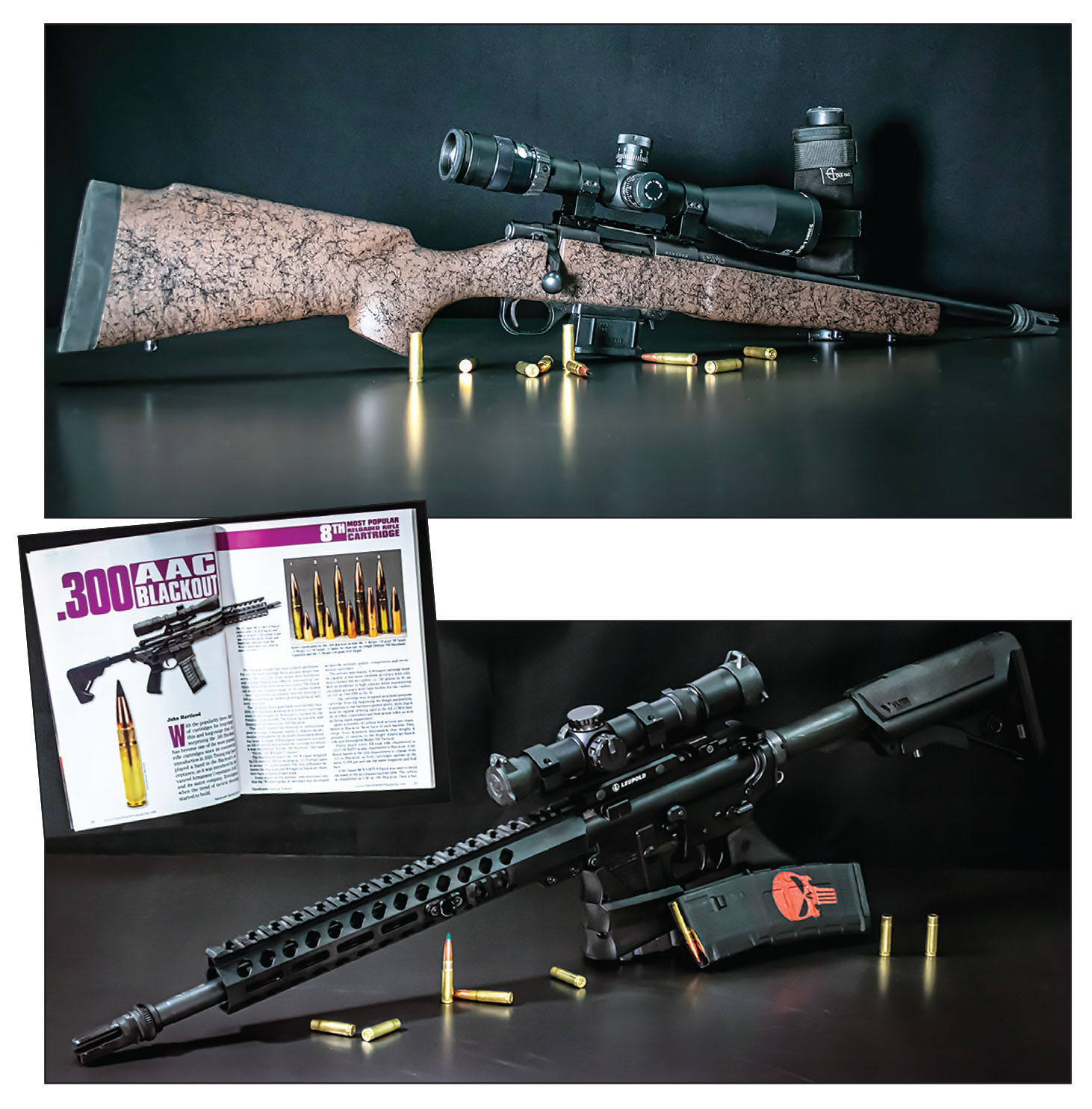
Two rifles were selected for testing. The first was a Howa mini-action with a 16-inch barrel and the second was an AR-15, also featuring a 16-inch barrel.
The .300 Whisper/Blackout is an interesting cartridge because of its history, military interest and versatility. The concept for the cartridge must be credited to J.D. Jones of SSK Industries and dates back to the 1990s when the .300 Whisper was born by shortening and necking up .221 Remington Fireball cases to accept .308-inch diameter bullets. If I look back to 2011, the .300 Whisper was essentially reintroduced by Advanced Armament Corporation as the .300 AAC Blackout, which was approved by the Sporting Arms and Ammunition Manufacturers’ Institute (SAAMI) while the .300 Whisper remained a wildcat cartridge. The .300 Whisper is essentially survived by the .300 Blackout and many barrelmakers are chambering the cartridge.
Research seems to indicate the only difference between the cartridges is in the chamber where the neck of the case would be. The claim is that the .300 Blackout cases can be formed from .223 or 5.56 NATO cases without having to ream or turn case necks. Without having a .300 Whisper chambered rifle, I cannot confirm or invalidate these statements. It should be noted that the .300 Whisper and .300 Blackout are cross compatible and can be fired in either chamber safely. A glance at rifle die sales from all major manufacturers from 2019 showed that the .300 Blackout was the eighth most popular rifle die set sold. To this day, there is still a lot of interest in the cartridge.
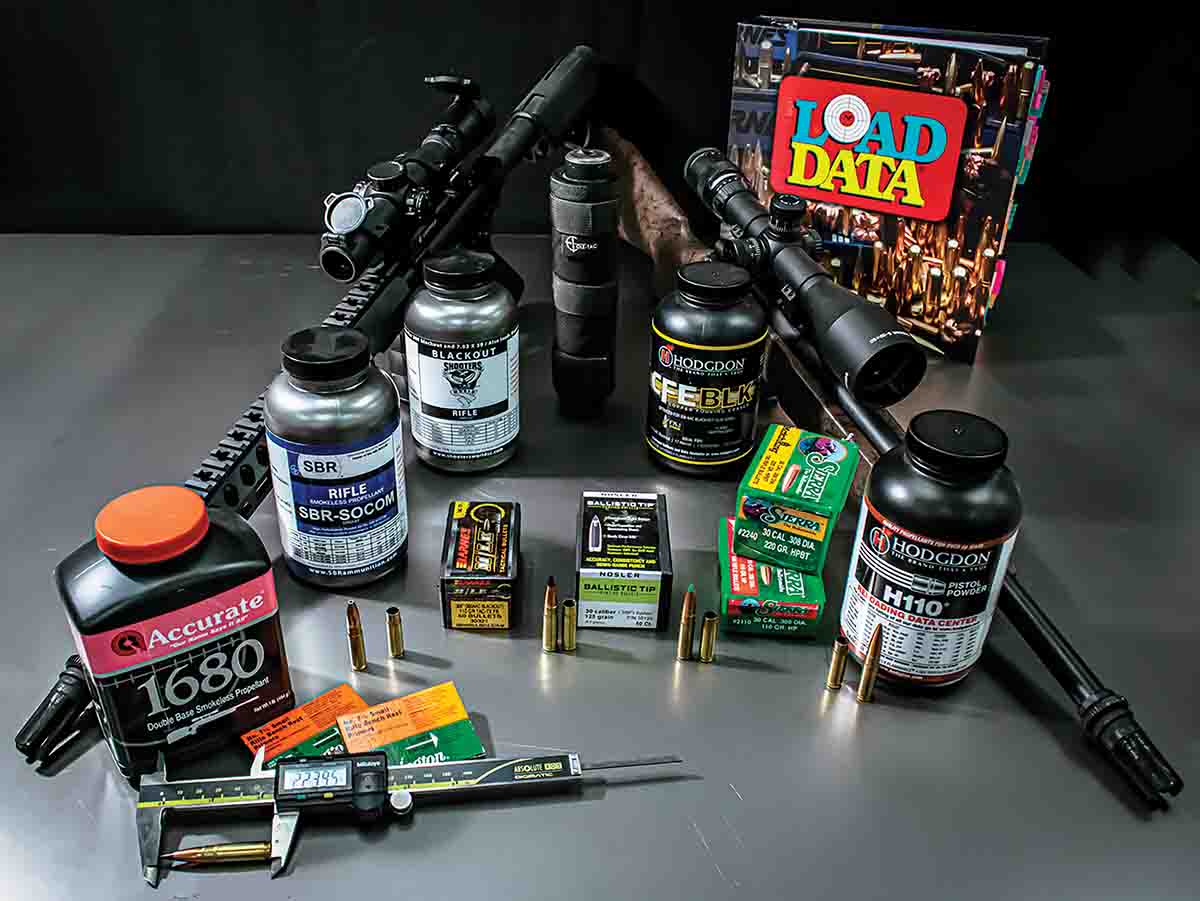
Powders that were ideal in burn rate for the .300 Blackout were selected for all testing, along with components that were proven performers in previous testing.
Sorting out the fact from fiction can be difficult, as many wild and bold claims have been made surrounding this cartridge, from it being a “subsonic sniper cartridge” to the age-old it’s better than your, “fill in the blank.” The truth about this cartridge has always been rather black and white when considering the facts and it does have some unique properties that many riflemen find to be beneficial for their goals, such as obtaining good velocity and energy levels from a short barrel. This is due to the powder burn rates the .300 Blackout takes advantage of. It also can easily switch between quiet subsonic ammunition to supersonic ammunition, allowing an increase in effective range and the number of scenarios that the rifle could be utilized in. With the use of a suppressor, it is impressive how quiet the .300 Blackout is with subsonic ammunition. This was a driving force behind the U.S. military and its interest in the cartridge.
The .300 Blackout can utilize bullets ranging from about 110 grains to about 240 grains and is easily adapted to fit in the AR-15. Swapping a .223 Remington or 5.56 NATO-chambered rifle is relatively simple, generally only requiring a barrel swap and in some cases a magazine swap. All this certainly adds to the popularity of the cartridge. How much this would help a shooter with their goals is up to the reader. Taking all this into account, this cartridge is quite a play-ground for the handloader and there is much versatility here and there are many lessons to be had from this cartridge. Ballistically, it is very similar to the 7.62x39, but the bullet range is wider for the .300 Blackout due to its .308-inch diameter bullets as opposed to the .312-inch diameter of the 7.62x39mm. Thus, the .300 Blackout offers more versatility, especially when considering the two platforms the cartridges are commonly available in, but that is a debate for another day.
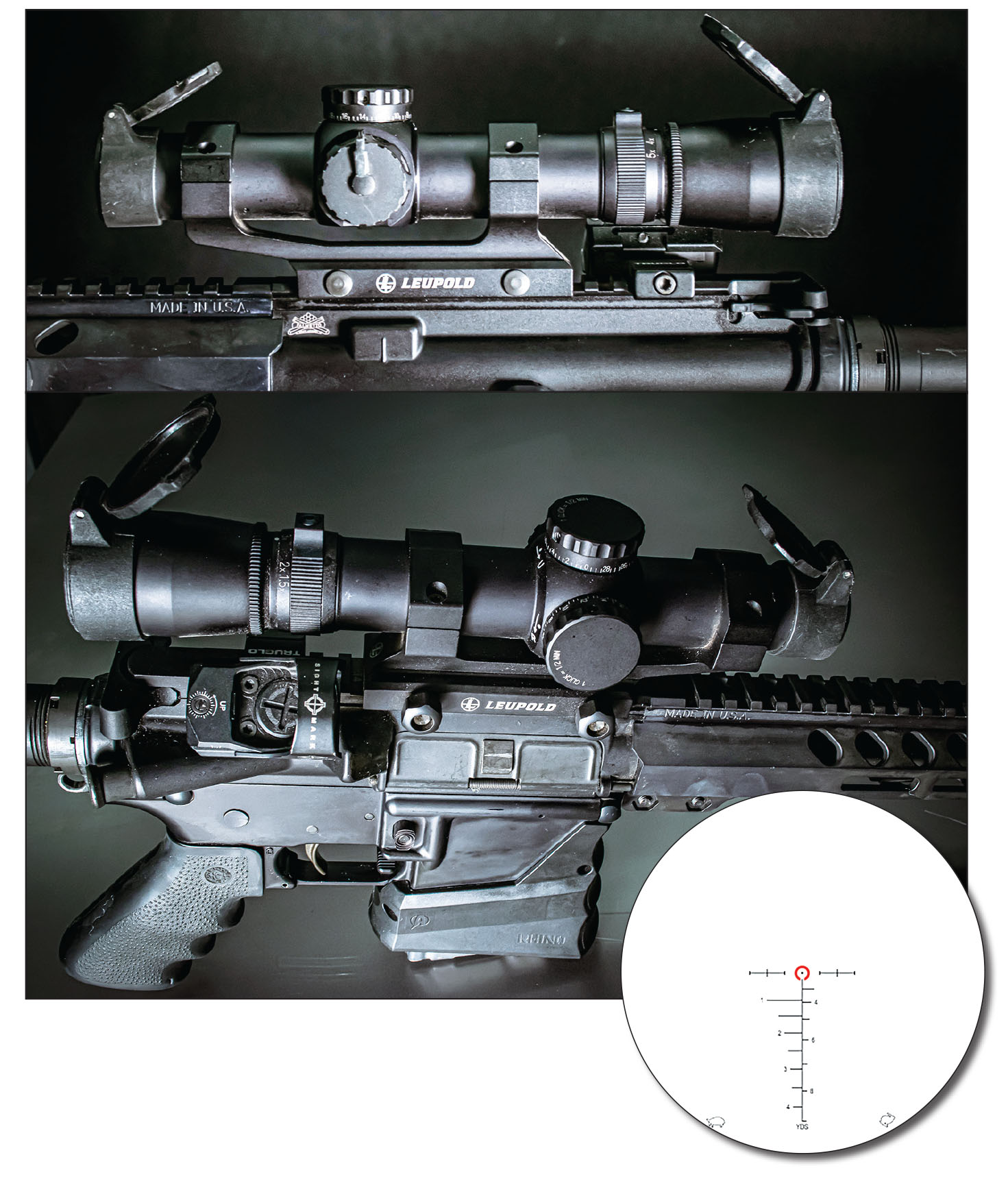
An excellent optic for the .300 Blackout is the Leupold Mark 4 MR/T 1.5-5x 20mm scope that features an illuminated reticle specifically made for the .300 Blackout and offers holdover points for both subsonic and supersonic ammunition. Sadly, this option has been discontinued by the manufacturer at the time of this writing.
In testing this cartridge, two rifles were selected, with the first being a Howa mini-action, bolt-action rifle with a 16-inch barrel, purchased as a barreled action from Brownells. A Bell & Carlson M40-style stock was added to the action without bedding and torqued to specifications. The barrel is free-floated and was topped with a Warne 20-MOA rail, with a Trijicon AccuPoint 5-20x 50mm scope secured in Leupold QRW-2 rings. The rifle features the HACT Trigger, which breaks smoothly at about 4 pounds. The second rifle I selected is a cobbled-together AR-15 with an Anderson Lower and a Palmetto State Armory (PSA) upper and barrel. The barrel was made for PSA by FN and is 16 inches long. A Timney Trigger was added, which breaks crisply and cleanly at 2.7 pounds. It features a Leupold Mark 4 MRT 1.5-5x 20mm scope with the .300 Blackout reticle, which offers holdover points for both supersonic and subsonic ammunition. Both rifles were tested with an AAC 7.62SD suppressor attached and a Cole Tac suppressor cover to help mitigate mirage.
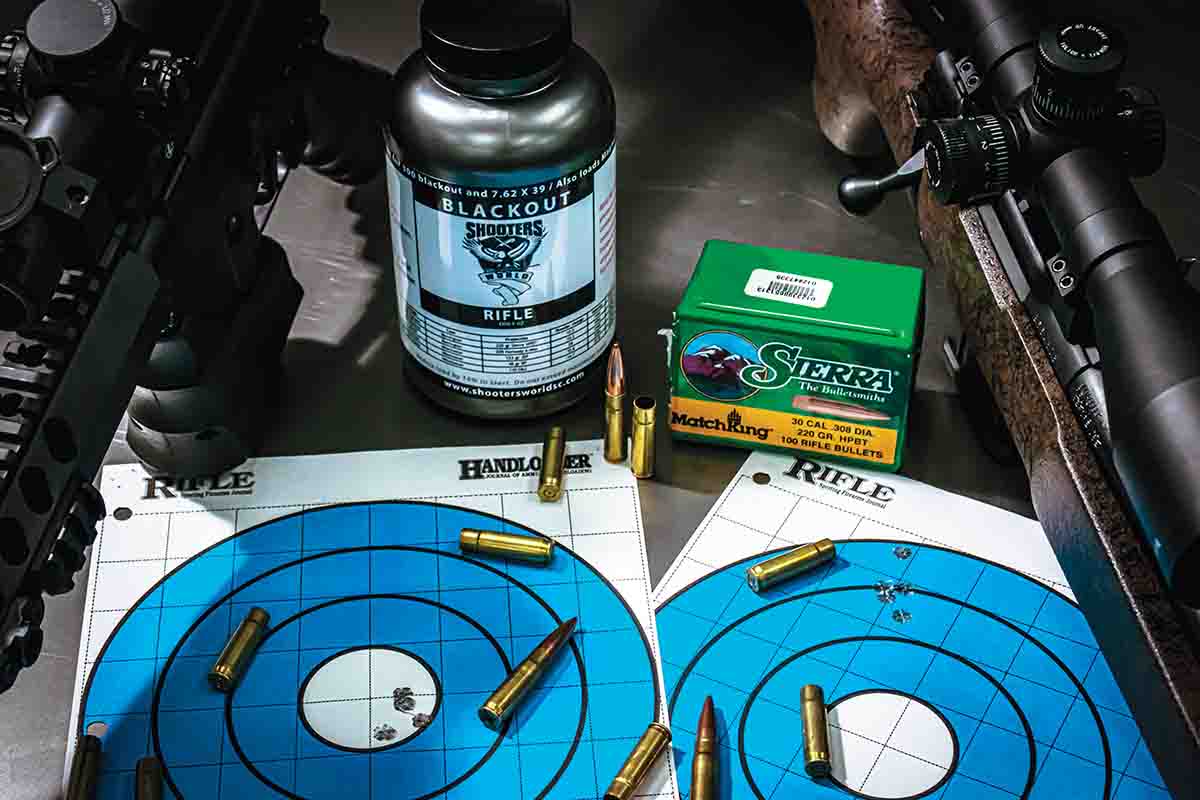
The exact same loads were tested in both rifles, and with enough load development, loads that performed well in both rifles could be found. Finding a load that performs well in both rifles can be extremely beneficial to the handloader.
When it comes to handloading for this cartridge, the procedure can be as simple or complex as desired. For the sake of this article, the process was kept simple. A Redding T-7 Turret press and Redding Deluxe die set was used to full-length size all cases. The included seating die was used to seat all bullets. A Lee factory crimp die was used to apply a light crimp to all loaded rounds, to keep the bullet in place under recoil and to aid in consistent powder burn. All powder was weighed and dispensed on an RCBS MatchMaster scale that is accurate to .04 grains. While these methods were used to test these loads, this is certainly not the only way to load for the .300 Blackout.
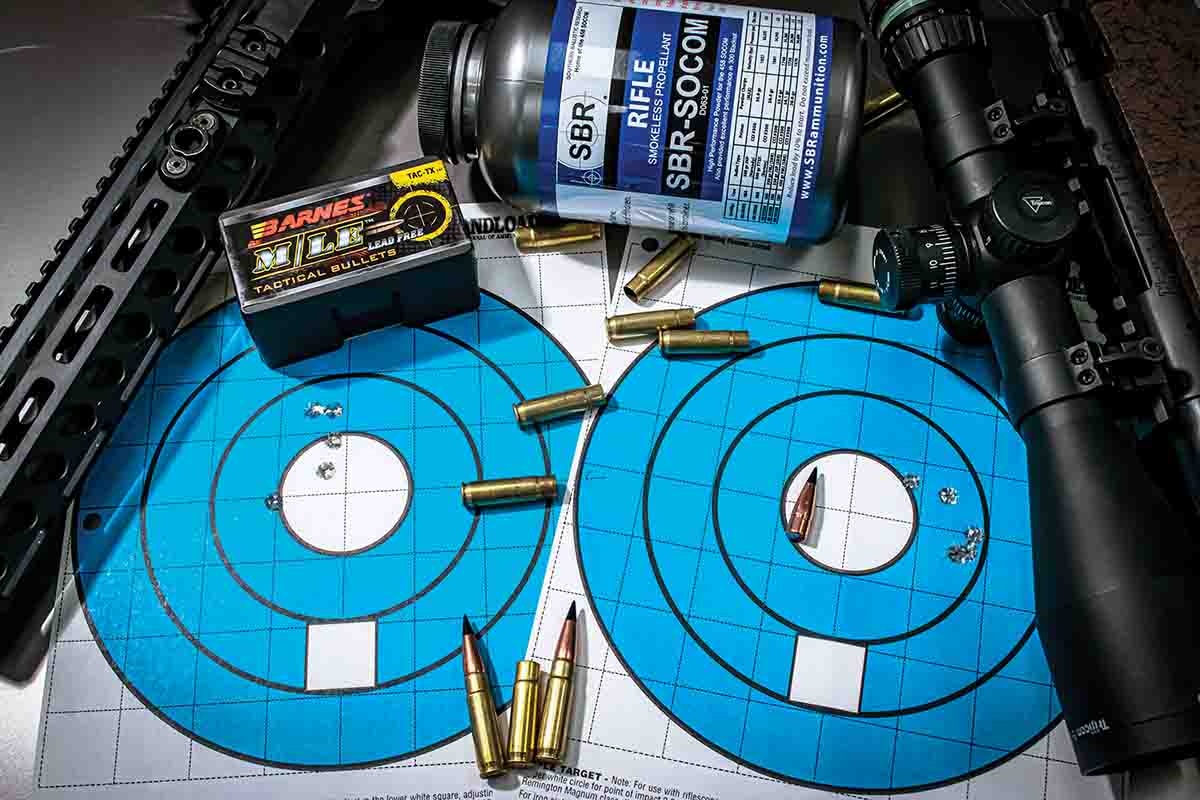
A favorite powder and bullet combination is Shooters World SBR SOCOM powder, which has proved itself as an outstanding powder for the .300 Blackout and the Barnes Tac-TX bullet, which expands reliably at the low velocities of the .300 Blackout. Finding a load that worked well in both rifles took some extra time but was well worth the effort.
Another preferred method with bolt-action rifles is to simply neck size brass until it will no longer easily chamber, which can take multiple firings, especially with subsonic ammunition. From there, a handloader can use a full-length sizing die to “bump” the shoulder .002 inch. This method helps squeeze every bit of accuracy from the rifle and load. With the AR-15, the shoulder is typically bumped .004 inch or so to ensure there are no feeding issues.
The results of this testing speak for themselves, plus adding in a bit of my own personal experience with the cartridge. It is capable of achieving sub-MOA accuracy at 100 yards. However, a lot of tinkering is required to do so, and a load in one rifle may not necessarily work well in another rifle, but with enough effort, some crossover between rifles is possible. So don’t be discouraged if initial results do not show promise. Putting in the extra time to develop a good load will pay off in the end. While developing loads, Shooters World SBR SOCOM powder showed low extreme spreads and standard deviations across multiple loads. It seemed to offer nearly ideal performance in the .300 Blackout. Having shot both rifles consistently for years now, they have taught me a lot about handloading, from forming cases to the effects the transonic zone has on bullets. The .300 Blackout can also make a great cartridge choice for testing bullet performance at lower velocities. When shooting these rifles suppressed, it brings a great deal of joy to hear the delay of a bullet striking steel and the satisfying sound echoing away. A glance at the accompanying table will help sort out fact from fiction when it comes to this cartridge, allowing the reloader to make an educated decision if this cartridge is worth adding to his collection or not.
For more information, be sure to watch the video “Handloading the .300 Blackout Suppressed” on Handloader TV.







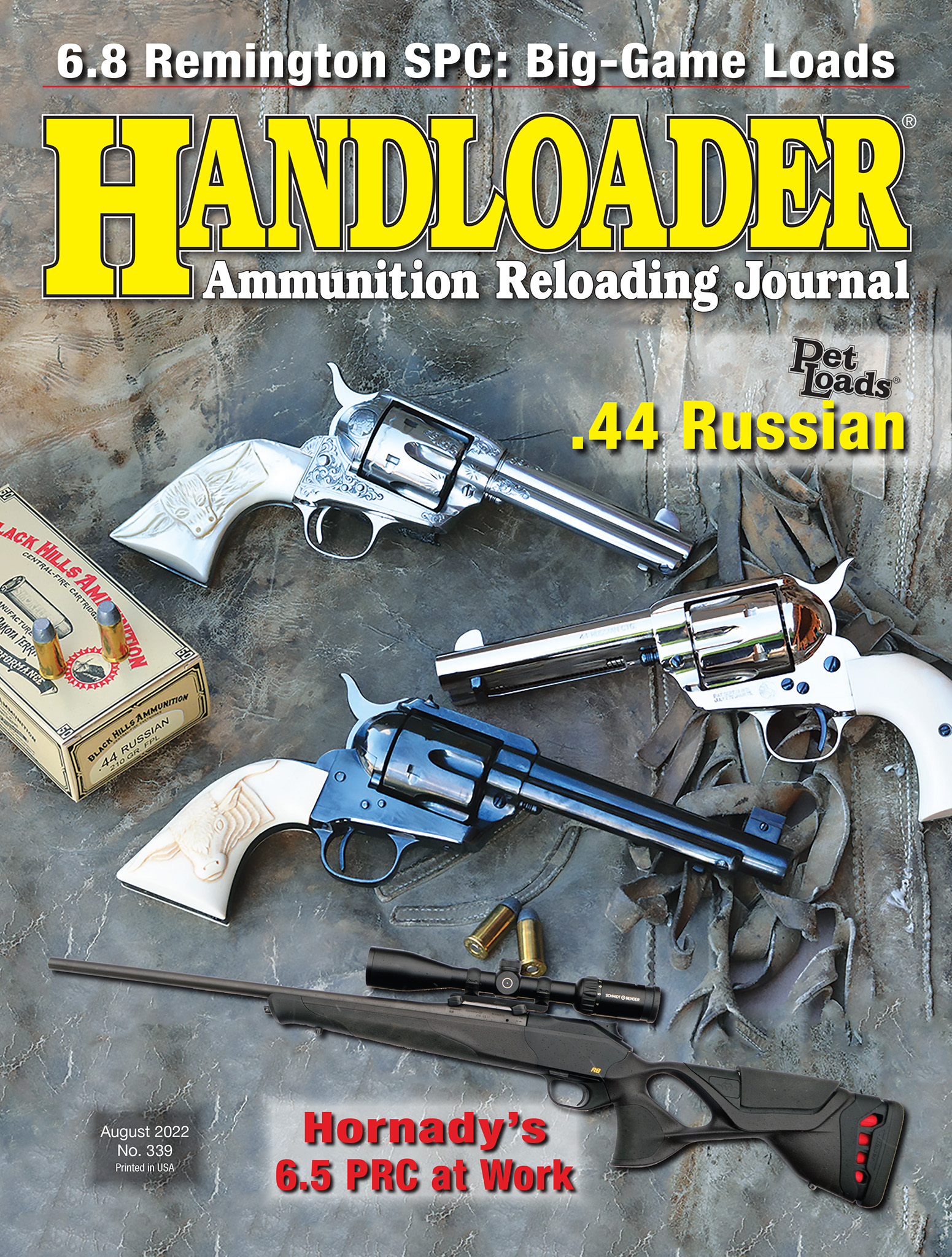
.jpg)